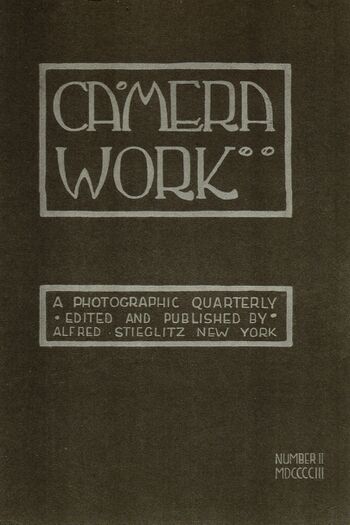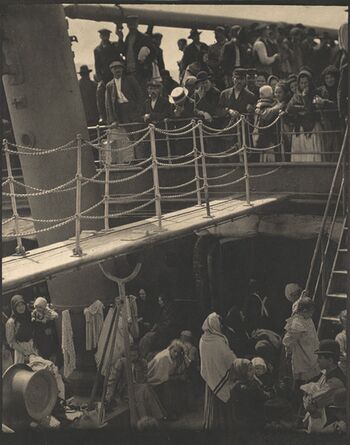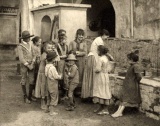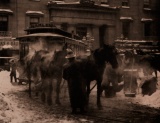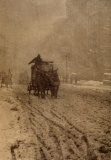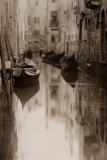Alfred Stieglitz
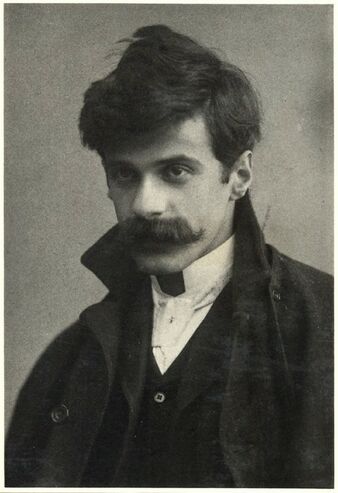 Alfred Stieglitz, self-portrait, c1894. | |
| Born |
January 1, 1864 Hoboken, New Jersey, US |
|---|---|
| Died |
July 12, 1946 (aged 82) New York, US |
Alfred Stieglitz (1864 – 1946) was an American photographer and promoter of photography as art. In the early history of photography he represents pictorialist movement. Contrary to scientists, artists looked at photography as a creative medium which was complementary and comparable to painting. Pictorialism, a movement that became dominant in the 1890s, explicitly aimed to differentiate artistic photography from scientific photography by treating the former as painting.
Life and work
In the 1880s his family moved to Europe and young Alfred began studying mechanical engineering at the Technische Hochschule in Berlin. There he met in a chemistry class Hermann Wilhelm Vogel, who was an important scientist and researcher in the then developing field of photography.
In 1882, he switched from engineering to chemistry, and at the same time began experimenting with photography. He bought his first camera (8x10 plate film camera with a tripod) and traveled through the European countryside, taking many photographs of landscapes and peasants in Germany, Italy and the Netherlands. In 1884 his parents returned to America, but Stieglitz remained in Germany for the rest of the decade.
During this time Stieglitz began to collect the first books of what would become a very large library on photography and photographers in Europe and the U.S. He read extensively as he collected, and through his library he formulated his initial thinking about aesthetics and photography.
In 1887 he wrote his very first article, "A Word or Two about Amateur Photography in Germany", for the new magazine The Amateur Photographer. Soon he was regularly writing articles on the technical and aesthetic aspects of photography for magazines in England and Germany.
Stieglitz's first photographic recognition was with The Last Joke, Bellagio (1887), photograph who won 1st place in the annual holiday competition held by the British magazine Amateur Photographer.
Several German and British photographic magazines began publishing his work from 1888, when he won both first and second prizes in the same competition. In 1890 after the death of her sister Flora, he returned to New York.
In the spring of 1893 he accepted the job of co-editor of The American Amateur Photographer and he wrote most of the articles and reviews in the magazine.
In early 1894 Stieglitz took his wife (Emmeline Obermeyer) on a honeymoon to Europe, and they traveled around France, Italy and Switzerland. Stieglitz photographed extensively on the trip, producing some of his early famous images such as A Venetian Canal, The Net Mender and A Wet Day on the Boulevard, Paris.
In the 1900s Stieglitz already considered himself an artist with a camera, writes articles for The American Amateur Photographer magazine and continued to win awards for his photographs at exhibitions, including the highly important joint exhibition of the Boston Camera Club, Photographic Society of Philadelphia and the Society of Amateur Photographers of New York.
Camera Work (1903-1917)
While the magazine Camera Notes set the standard for photographic magazines in the United States, Stieglitz raised the bar even farther with the subsequent journal Camera Work. In 1903 he left the "Camera Club" of New York, established his own group of photographers (the Photo-Secession), and commenced Camera Work, over which he had total control as both editor and publisher. Issued quarterly until the outbreak of World War I, this periodical definitively proved that photography was, indeed, as potent a form of art as painting and sculpture.
Stieglitz achieved this largely through the photogravure plates that graced the 50 issues of Camera Work. He often asked photographers to supply original negatives for plate making and to approve proofs, and he demanded the highest quality from his printers. The gravures usually were printed on delicate Japanese tissue, mounted on textured papers, and individually tipped into the magazines. In each issue, the illustrations were segregated from the magazine's text, creating discrete portfolios of images for quiet contemplation. Stieglitz believed the gravures were equivalents of original photographs, on equal standing with the photographers' platinum or gum-bichromate prints. Prominent pictorialists such as Gertrude Kaesebier, Edward Steichen and Stieglitz himself were well represented in the pages of Camera Work. In 1917, Stieglitz published the last issue, featuring realistic and abstract images by Paul Strand that signaled the dawning of photographic modernism. Today, Camera Work is probably the single best-known example of gravure printing [1].
The Steerage
While on his way to Europe (1907) Stieglitz took what is recognized not only as his signature image but also as one of the most iconical photographs of the 20th century. Aiming his camera at the lower class passengers in the bow of the ship (the "SS Wilhelm II"), he captured a scene he titled The Steerage. By the time he returned to New York he was so caught up in other business that he set it aside and did not publish or exhibit it until four years later. In his memoirs, he recalls the taking of this photograph as follows:
"A round straw hat, the funnel leaning left, the stairway leaning right, the white drawbridge with its railings made of circular chains—white suspenders crossing on the back of a man in the steerage below, round shapes of iron machinery, a mast cutting into the ski, making a triangular shape. I stood spellbound for a while, looking and looking and looking. Could I photograph what I felt, looking, looking and still looking? I saw shapes related to each other. I saw a picture of shapes and underlying that the feeling I had about life". (Stieglitz, 1942-43, p. 128)
With The Steerage, Stieglitz found a satisfactory balance between his photographic practice and his experimental philosophy. All his subsequent production is informed by his experimental quest for conceptual representations. By challenging naive photographic realism and the simplistic subjectivity of Pictorialism, he devised an entirely novel relation at the basis of photographic representations.
Gallery
Literature
- Newhall Beaumont, The History of Photography from 1839 to the Present Day, 1939, New York: The Museum of Modern Art, 1982, pp 167-168.
- Richard Whelan, Alfred Stieglitz: A Biography, New York: Little, Brown, 1995.
- Simone Philippi, Ute Kieseyer (ed.), Alfred Stieglitz, Camera Work The Complete Photographs. 1903-1917, Benedikt Taschen, 1997; repr., 2008, ARG.
- Marcia Brennan, Painting gender, constructing theory: the Alfred Stieglitz Circle and American formalist aesthetics, MIT Press, 2001.
- Martin W. Sandler, Photography: An Illustrated History, Oxford University Press, 2002.
- Katherine Hoffman, Stieglitz: A Beginning Light, New Haven: Yale University Press, 2004.
- Ya'ara Gil Glazer, "A new kind of history? The challenges of contemporary histories of photography", Journal of Art Historiography 3, Dec 2010.
